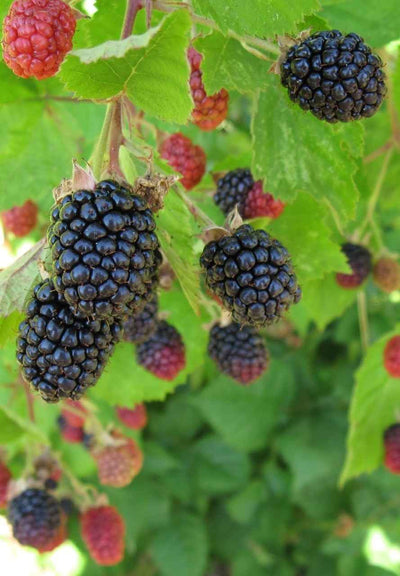The Best Ways to Grow and Take Care of Lowbush Blueberry Shrubs
Lowbush blueberry shrubs (Vaccinium angustifolium) brighten gardens and yield berries for home and garden. In measures of compactness and yield, these shrubs reign supreme, and it’s no wonder they find themselves in the backyards of many a North American home. In this guide, we will look at the lowbush blueberry shrubs’ care, its growth characteristics, and how to grow them successfully.
What is a Lowbush Blueberry Shrub?
Like all members of the blueberry family Vaccinium, lowbush blueberry shrubs are classed as perennials. They grow and spread low to the ground, which in some cases is perfect for ground cover or if you’d like a small, simple shrub. Shrubs like these grow to as small as 6-8 inches and as big as 2 feet, and taller if conditions are great!
These types of blueberries have a sweet yet tart flavor, which is why a lot of people use them in any type of culinary art, such as baking or creating certain preserves. Unlike the highbush type, which spread across the ground in a patch, the lowbush serves as natural ground cover. This species, as well as many others, thrives in various climatic zones, making them a perfect choice for people who want low-maintenance plants.
The lowbush blueberry shrub has various defining characteristics. In this case, the plants have small, oval-shaped leaves with edges that are characteristic spines. These leaves tend to grow in pairs along the stems. Throughout the summer, the leaves are a bright green, which in fall turns into a fiery orange or red. The stems of lowbush blueberries are fragile and woody, which bends easily and breaks easily when disturbed.
The lowbush shrub that produces either white or pink flowers is the only type which other species cannot. Ripened berries hang in a circular bush of innumerous sweet sips in the middle of summer. Due to the maturation in phases, the berries can be picked for weeks.
How to Take Care of Lowbush Blueberry Shrubs
You can directly take care of lowbush blueberry shrubs without any special skills as long as you keep in mind a couple of things:
-
Soil Requirements: Lowbush blueberries greatly appreciate low to moderate acidic to neutral soil with a pH of 4.8 to 6.0. They require sandy soil and/or loam soil and appreciate incorporation of organic materials like peat moss prior to planting to preserve acidity and nutrients.
-
Watering Needs: Although lowbush blueberries are drought-tolerant, you can provide them with a dose of water during the growing season. You should also protect the plant from overwatering, as this can make them waterlogged and lead to root rot. They should not have constant moisture. Water them until the soil has dried about an inch from the surface.
-
Sunlight Requirements: Lowbush blueberries are sun-loving plants that need 6 hours of sunlight daily. They do have some tolerance to partial shade with some plants protected from the blazing sun in the afternoon. They are less likely to stand the heat of the sun. In that case, the leaves will start to turn yellow.
-
Pruning and Maintenance: When it comes to lowbush blueberries, there is no need to do any regular pruning. If you want the plants to look neat, do some pruning in the early spring right before the plant starts to get new leaves. The ideal stems to cut are the dead ones, which encourages new shoots.
How to Grow Lowbush Blueberry Shrubs
To grow the lowbush blueberries, follow these steps:
-
Choose a Location: The location should have well-drained, acidic soil and a minimum of 6 hours of sunlight per day.
-
Prepare the Soil: Organic matter should be added to the soil to help the soil with drainage and increase the acidity.
-
Planting: Create a hole that is about twice the width and depth of the shrub’s root ball. Place the plant in the hole and backfill with the amended soil. Be sure to plant the root ball at the same depth as it was in the container.
-
Water and Mulch: Once planted, water the shrub continuously and add a 2–3 inch mulch to conserve moisture and prevent weeds.
-
Maintain: During the initial couple of years as the plant settles, make sure to water the plant, especially during dry periods. Light pruning and mulching will keep the shrub in good condition.
Other Berry Shrubs You Can Grow
Blueberry bushes make a lovely addition to many gardens but shrubs bear other berries too, which are equally appealing:
-
Highbush Blueberry: These bushes are taller than the lowbush varieties and are cultivated mostly for their larger fruit production. They require a bit more spacing and more frequent tending, which is worth it for the greater return on yield.
-
Raspberry Shrubs: If you love the taste of tart, juicy berries, consider growing raspberry bushes. These shrubs also enjoy full sun and well-drained soil, producing fruit in summer.
-
Blackberries: For those folks who like sweet and tangy fruits like raspberries, blackberries are also a great option. They are best grown in slightly acidic soil and exposed to plenty of sunshine.
-
Gooseberries: Gooseberry bushes are very hardy and can be grown in nearly every kind of climate and are also easy to grow. Gooseberries can be used to make jams, jellies, and even pies.
FAQs
How big do lowbush blueberry bushes get?
Lowbush blueberry bushes grow a maximum of 6 - 8 inches wide and can spread up to 2 feet in diameter. If the shrubs are in perfect conditions, they can grow to a maximum of 3 - 4 feet and produce more fruit. They are perfect for ground cover shrubs and are very compact in size.
Do lowbush blueberries spread?
Yes, lowbush blueberries run their fingers through the runners, which creates a plant patch. Naturally, they cluster closely for easier ground cover as they propagate. This helps to spread new fruit and create even more plants over time.
Are lowbush blueberries sweet?
Partial to low bush blueberry bushes? If so, you will surely enjoy the taste of the fruits. Not only are they blue in color, but also are sweet and have a tinge of bitterness. Also, picking these berries is a delight since they ripen in phases, so the more berries you pick, the more sweetness you will experience. Oftentimes, these fruits are eaten with no other ingredients, enjoyed in baked goods, or enjoyed with preserves. Most individuals enjoy the flavors these berries offer.
Can you eat lowbush blueberries?
Yes, it is perfectly acceptable to consume lowbush blueberries. In fact, many people eat them straight from the bushes, as they are known for their sweet and tangy taste. With their mouthwatering flavor and high nutritional value, these berries are used in many recipes, such as pies, jams, and smoothies, as well as snacks.
What not to plant near blueberry bushes?
Do not plant dubious types of bushes close to blueberry bushes. Plants such as lavender and asparagus require alkaline soil and should not be planted in close proximity to blueberries. Also to be avoided are aggressive plants, such as mint, or those which will intensely compete for nutrients. Ideally, these bushes will be grown with other plants which favor the same acidic soil range, such as strawberries.
Why do doctors say to quit eating blueberries?
There is no claim or statement that has proven blueberries should be fully avoided. For some individuals allergies and gut issues might arise, and that is not healthy. If you are someone that is sensitive to certain fruits, consult with your primary doctor before consuming them.


